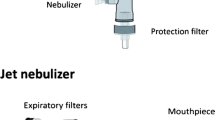Abstract
We report the validation of a new delivery system — aerosol production equipment (known by the acronym APE), which generates a particulate aerosol of technetium 99m diethylene triamine penta-acetic acid (DTPA) with a mass-median aerodynamic diameter of 0.35 μm and a geometric standard deviation of 1.8 Twenty subjects were studied; in group 1 were 12 healthy men with normal spirometry; in group 2 were 8 men with AIDS who had mildly abnormal lung function following an episode of pneumocystis pneumonia-spirometry FEV1 3.08 (0.73) L, FVC 4.83 (0.82) L [mean (SD)]. The APE nebulizer was used to form a particulate aerosol with 200 MBq of99mTc DTPA, which was collected in a 351 reservoir of air, which was subsequently inhaled. The mean (SD) inhalation time was 4.7 (0.44) min. The output of the nebulizer (% of activity inhaled) was 82%. Using planar imaging, the penetration index (right lung) in group 1 was 0.93 (0.18), mean (SD), and in group 2 it was 0.91 (0.12). There was virtually no tracheal deposition and extrapulmonary deposition (oropharynx and stomach) was less than 5% of the aerosol delivered. Single-photon emission tomography (SPET) studies carried out in five patients from group 1 confirmed homogeneous intrapulmonary deposition of99mTc-DTPA. In view of the excellent intrapulmonary deposition of99mTc-DTPA produced by the APE nebulizer, it may provide an alternative to conventional ventilation studies using radioactive gases.
Similar content being viewed by others
References
Agnew JE, Bateman JRM, Pavia D, Clarke SW (1984) Radionuclide demonstration of ventilatory abnormalities in mild asthma. Clin Sci 66:525–531
Albert RC, Lippmann M, Spiegelman J (1967) The deposition and clearance of radioactive particles in the human lung. Arch Environ Health 14:10–15
Brain JD, Valberg PA (1979) Deposition of aerosol in the respiratory tract. Am Rev Respir Dis 120:1325–1373
Bryan AC, Bentivoglio LG, Beerel F, MacLeigh M, Zidulka A, Bates DV (1964) Factors affecting regional distribution of ventilation and perfusion in the lung. J Appl Physiol 19:395–402
Buxton-Thomas MS, Wraight EP (1984) The use of99mTc-DTPA aerosol ventilation scintigraphy in the diagnosis of pulmonary embolism. Nucl Med Commun 5:387–391
Chamberlain MJ, Morgan WKC, Vinitski S (1983) Factors influencing the regional deposition of inhaled particles in man. Clin Sci 64:69
Clay MM, Pavia D, Newman SP, Clarke SW (1983) Factors influencing the size distribution of aerosols from jet nebulizers. Thorax 38:755–759
Coates G, O'Brodovich H (1986) Measurement of pulmonary epithelial permeability with99mTc-DTPA aerosol. Semin Nucl Med 16:275–284
Dautrebande L, Walkenhorst W (1961) Ober die Retention von Kochsalzteilchen in der Atemwegen. In: Davies CN (ed) Inhaled particles and vapours. London, Pergamon Press, pp 110–121
Francis RA, Agnew JE, Sutton PP, Pavia D, Clarke SW (1981) Ventilation imaging with easily prepared99mTc aerosols. Nucl Med Commun 2:203–208
Jones JG, Minty BD, Royston D (1982) The physiology of leaky lungs. Br J Anaesth 54:705–721
Lourenco RV, Cotromanes E (1982) Clinical aerosols. 1. Characterisation of aerosols and their clinical uses. Arch Intern Med 142:2163–2172
Milič-Emili J, Henderson JAM, Dolovich MB, Trop D, Kaneko P (1966) Regional distribution of inspired gas in the lung. J Appl Physiol 21:749–759
Miller RF, Godfrey-Faussett P, Semple SIG (1989) Nebulised pentamidine as treatment forPneumocystis carinii pneumonia in the acquired immunodeficiency syndrome. Thorax 44:465–569
Morrow PE (1964) Evaluation of inhalation hazards based upon the respirable dust concept and the philosophy and application of selective sampling. Am Ind Hyd Assoc J 25:213–236
Newman SP, Pellow PGD, Clay MM, Clarke SW (1985) Evaluation of jet nebulizers for use with gentamicin solution. Thorax 40:671–676
O'Doherty MJ, Thomas S, Page C, Barlow D, Bradbeer C, Nunan TO, Bateman NT (1988) Differences in relative efficiency of nebulizers for pentamidine administration. Lancet 11:1283–1286
Pircher FJ, Temple Jr, Kirsch WJ, Reeves RJ (1965) Distribution of pulmonary ventilation determined by radioisotopic scanning. AIR 94:807–814
Rees PJ, Clark TJH (1982) The importance of particle size in response to inhaled bronchodilators. Eur J Respir Dis 63 [Suppl 119]:73–78
Smalldone GC, Perry RJ, Deutch DG (1988) Characteristics of nebulisers used in the treatment of AIDS-related Pneumocystis carinii pneumonia. J Aerosol Med 1:113–126
Swift DL (1980) Generation and respiratory deposition of therapeutic aerosols. Am Rev Respir Dis 122:71–77
Woolman PS, Coutts CT, Mole DR, Dendy PP, Higenbottam TW (1989) Sites of deposition of aqueous aerosols; a study of efficiency of delivery systems for lung ventilation imaging in man. Nucl Med Commun 10:171–180
Author information
Authors and Affiliations
Rights and permissions
About this article
Cite this article
Miller, R.F., Jarritt, P.H., Lui, D. et al. The APE nebuliser — a new delivery system for the alveolar targeting of particulate technetium 99m diethylene triamine penta-acetic acid. Eur J Nucl Med 18, 164–170 (1991). https://doi.org/10.1007/BF02262726
Received:
Revised:
Issue Date:
DOI: https://doi.org/10.1007/BF02262726




